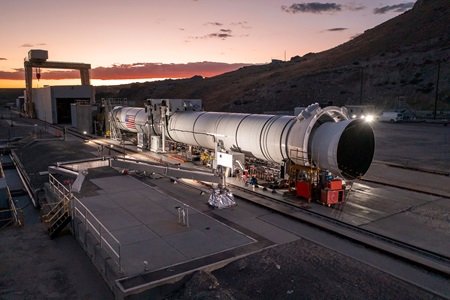Named after the twin sister of Apollo in Greek mythology, NASA’s Artemis puts the work of women at the forefront.
Beyond the Boost


By Brooks McKinney
In December 2022, NASA’s Orion spacecraft splashed down in the Pacific Ocean west of Baja, California, successfully concluding the Artemis I mission and adding momentum to preparations for Artemis II. The latter will be the first crewed flight in NASA’s cadence of missions that will ultimately land the first woman and the first person of color on the moon.
As the provider of the twin solid rocket boosters that power NASA’s Space Launch System and two of the three solid rocket motors that enable Orion’s launch abort system, Northrop Grumman played a key role in the success and safety of the Artemis I mission and is helping NASA move forward to the next Artemis missions. The space agency plans to use the Artemis missions to explore and establish a long-term presence on the moon, which will help inform its goal of eventually sending the first astronauts to Mars.

Tracking Orion in Space
During its first Earth orbit following launch, the Orion spacecraft — still attached to its Interim Cryogenic Propulsion Stage (ICPS) — flew over a region of the Pacific Ocean not visible to NASA ground stations. Unfortunately, that was exactly where the ICPS had to perform its Trans-Lunar Injection Burn to boost Orion from Earth orbit into lunar orbit.
To monitor the health and safety of the spacecraft during this time, NASA used a RangeHawk, a U.S. Department of Defense (DoD) high-altitude, long-endurance aircraft. RangeHawks were developed by NASA with our help, and are actually Northrop Grumman Global Hawk aircraft that have been reconfigured to support hypersonic missile flight testing by the DoD's Test Resource Management Center (TRMC).
"RangeHawk's mission was to fly out to a point about 1,400 miles west of San Diego, then 'look up' to collect telemetry data broadcast by the Orion spacecraft and ICPS as it flew overhead," said Brian Peck, Northrop Grumman's director of TRMC RQ-4 RangeHawk programs.
We helped NASA create the RangeHawks by replacing Global Hawk's original downward-facing sensors with a satellite dish antenna and several upward-facing payloads. NASA can use RangeHawks on future Artemis missions, Brian added, to save money and help the environment.
"Flying a single-engine RangeHawk out to the rendezvous point hours before launch would be less expensive and generate far fewer emissions than sending a large diesel-powered ship out to sea for several weeks," Brian said.
Helping Orion Keep Its Cool
We also helped ensure the safety of the Orion crew capsule, both in orbit and during re-entry to Earth. Since 2010, we've been supplying the phenolic material used to produce key components of the capsule's thermal protection system. These components shield the spacecraft from the hot gases it produces while controlling its on-orbit position and from the 4,000-degree Fahrenheit environment it experiences during re-entry.
"Phenolic components are designed to degrade and erode in a controlled fashion that carries heat away from the spacecraft," said Hank Dovey, Northrop Grumman's senior program manager for propulsion systems. "This ablative property prevents heat from transferring to astronauts or the spacecraft's underlying structure."
In other words, this insulation helps the capsule and crew return to Earth safely.

Welcoming the Orion Capsule Earth-Side
Around the same time as Artemis I’s re-entry, another Northrop Grumman team was working on a 150-kilowatt class laser that was installed on the U.S. Navy’s USS Portland. The laser tracked Orion’s splashdown journey and generated estimated location coordinates of the capsule’s location. Crews aboard the USS Portland recovered the Orion capsule and brought it back to land after splashdown.
“Northrop Grumman has supported NASA and its customers for the development of the Orion spacecraft, SLS vehicle and Artemis missions from the start,” said Hank. “We’ve leveraged our innovative technologies and knowledge and expertise to fully support Artemis I and execute the next phase of human space exploration.”
Learn more about our work on Artemis, or explore what life’s like working here at Northrop Grumman.
*Kendra Kastelan and Michelle A. Monroe contributed to this article.


